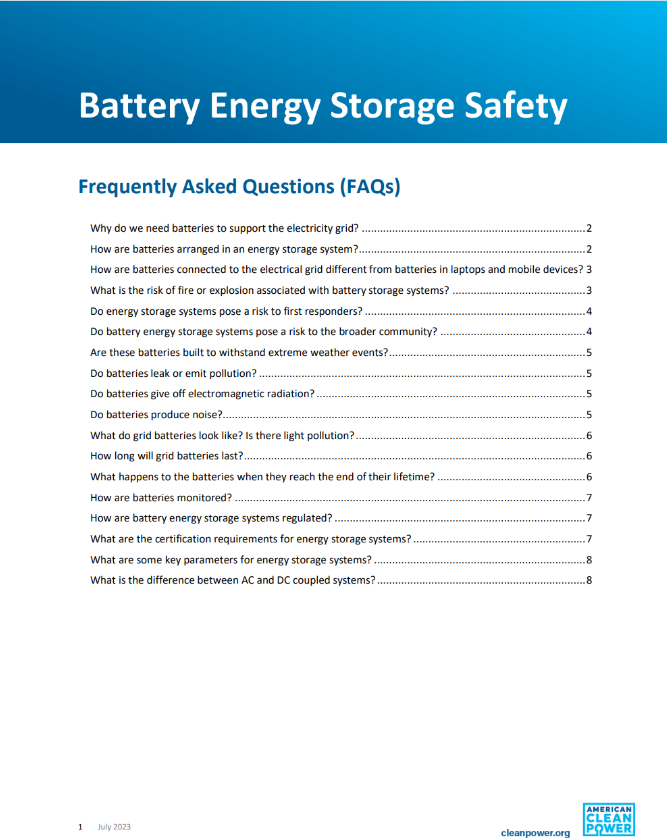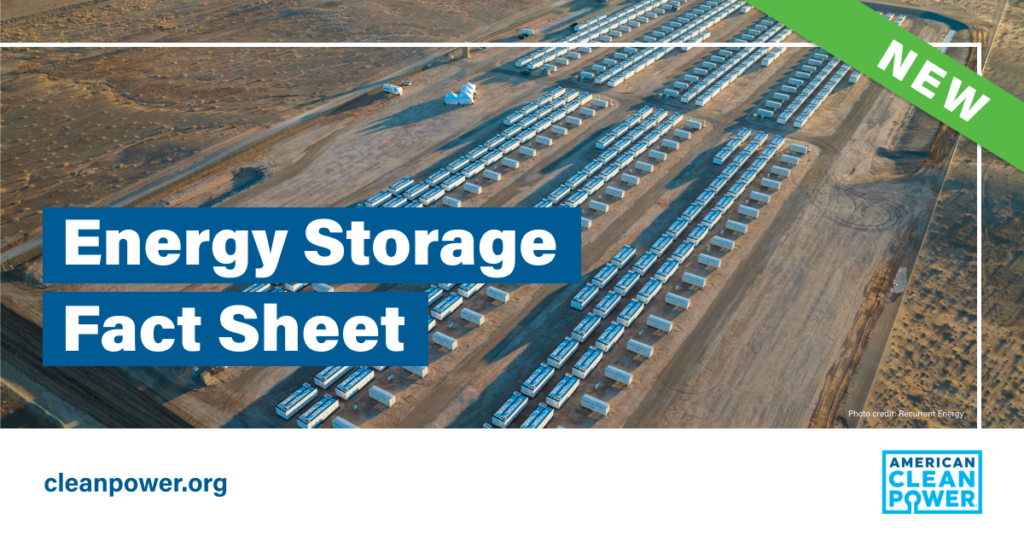Energy storage is a resilience enabling and reliability enhancing technology. Across the country, states are choosing energy storage as the best and most cost-effective way to improve grid resilience and reliability.
ACP has compiled a comprehensive list of Battery Energy Storage Safety FAQs for your convenience.
Read ACP’s FAQ document to learn more in detail.
The basics of battery energy storage safety
Why do we need batteries to support the electricity grid?
Energy storage fundamentally improves the way we generate, deliver, and consume electricity. Battery energy storage systems can perform, among others, the following functions:
- Provide the flexibility needed to increase the level of variable solar and wind energy that can be accommodated on the grid.
- Help provide back-up power during emergencies like blackouts from storms, equipment failures, or accidents.
- Lower costs by storing energy when the price of electricity is low and discharging that energy back onto the grid during peak demand.
- Balance power supply and demand instantaneously, which makes the electrical grid more reliable, resilient, efficient, and cleaner than ever before.
How are batteries arranged in an energy storage system?
Battery energy storage systems vary in size from residential units of a few kilowatt-hours to utility-scale systems of hundreds of megawatt-hours, but they all share a similar architecture. These systems begin with individual battery cells, which are electrically connected and then packaged in a battery module. Battery modules are aggregated with controls and other equipment and housed within racks, which in turn are built into an enclosure, such as a cabinet or ISO shipping container, or a building. One or more of these enclosures or buildings, along with necessary electrical equipment, comprise the battery energy storage facility that discharges to or charges from the electrical grid.
How are batteries connected to the electrical grid different from batteries in laptops and mobile devices?
Battery energy storage systems operate by converting electricity from the grid or a power generation source (such as from solar or wind) into stored chemical energy. When the chemical energy is discharged, it is converted back into electrical energy. This is the same process used with phones, laptops, and other electronic devices. However, while batteries in consumer electronics have a single function, those connected to the electrical grid — which are much larger — serve more complex functions. For instance, electrical grid batteries must be combined with power conversion devices to produce AC (alternating current) power. Batteries connected to the electrical grid can also have a different composition than those found in consumer electronics.
What is the risk of fire or explosion associated with battery storage systems?
Safety events that result in fires or explosions are rare. Explosions constitute a greater risk to personnel, so the US energy storage industry has prioritized the deployment of safety measures such as emergency ventilation to reduce the buildup of flammable gases. Such ventilation can reduce the effectiveness of fire suppression, so an increasing number of manufacturers have adopted a strategy of allowing fires in individual battery enclosures to burn out in a controlled manner, while also preventing the propagation of fire between enclosures. The rationale is that fire consumes any flammable gases as they are produced, thus preventing explosions. Additionally, allowing the battery to burn avoids problems with stranded energy and reignition, both of which have been issues with electric vehicle fires. The monitoring systems of energy storage containers include gas detection and monitoring to indicate potential risks. As the energy storage industry reduces risk and continues to enhance safety, industry members are working with first responders to ensure that fire safety training includes protocols that avoid explosion risk.
Do energy storage systems pose a risk to first responders?
Battery energy storage system operators develop robust emergency response plans based on a standard template of national best practices that are customized for each facility. These best practices include extensive collaboration with first responders and address emergency situations that might be encountered at an energy storage site, including extreme weather, fires, security incidents and more. They also address emergency response roles and highlight the importance of coordinating with first responders—particularly during planning—to ensure there is a complete and detailed shared understanding of potential emergencies and the proper safety responses. Emergency response plans also include contact details for subject-matter experts who can advise first responders on appropriate actions for each situation.
To learn more, read ACP’s Energy Storage Emergency Response Plan Template.
Do battery energy storage systems pose a risk to the broader community?
In the rare case where fires do occur, they may be managed without endangering broader communities. A study for the New York State Energy Research & Development Authority states that, while battery fires emit toxic fumes, the average level of toxicity is similar to that of plastics fires involving materials such as sofas, mattresses, or office furniture. Depending on the size of the facility, authorities may close nearby roads and issue shelter-in-place advisories to local residents. The diverse system components that comprise the energy storage facility have chemical and fire smoke data that can be utilized to determine the risks for each facility. The code-required Hazard Mitigation Analysis will summarize how risks beyond the site boundary will be prevented.
A September 2022 fire in California presents a case study where a thermal event was resolved with minimal effect to the local community. Fire broke out in one battery enclosure (out of 256). The fire did not spread to adjacent units, and firefighters had been trained to allow the fire to burn while protecting nearby exposures. After some hours, shifting winds caused a nearby highway to be closed and residents were advised to shelter in place with their windows closed. The fire burned itself out in five hours, leaving no possibility of reignition. Approximately 18 hours after the fire broke out, the highway was reopened and the advisory lifted when air-quality sampling around the facility showed no detectable traces of airborne contaminants.
Are these batteries built to withstand extreme weather events?
Battery energy storage systems are currently deployed and operational in all environments and settings across the United States, from the freezing temperatures of Alaska to the deserts of Arizona. These systems are designed with associated heating and cooling systems to ensure optimal battery operations and life based on the environmental conditions at the installation location. Not only are battery energy storage facilities built to withstand disruptive weather events, but they can also help increase resiliency to extreme weather events, prevent power outages, and provide back-up power.
Do batteries leak or emit pollution?
In normal operation, energy storage facilities do not release pollutants to the air or waterways. Like all energy technologies, batteries can present chemistry-specific hazards under fault conditions. Batteries with free-flowing electrolytes could leak or spill chemicals, so these systems are normally equipped with spill containment. Batteries with aqueous electrolytes may emit small quantities of hydrogen gas in normal operation and larger amounts under fault conditions, but these emissions are handled by ventilation systems and are not considered polluting. As discussed previously, all batteries release toxic substances in a fire, and if water is used for firefighting, it can create contaminated runoff – another reason for manufacturers’ recommendations to allow fires to burn themselves out.
Do batteries give off electromagnetic radiation?
Like batteries used in handheld devices, lithium-ion and other types of batteries do not give off electromagnetic radiation. These batteries store electrical energy in chemical form, which can be converted back into electrical energy and discharged back to the grid. This conversion is performed by a bidirectional inverter, which must be tested and certified for electromagnetic compatibility.
Do batteries produce noise?
Batteries alone do not make any noise. Unlike other power infrastructure or generation facilities, energy storage systems have very low noise profiles, with fans, HVAC systems, and transformers producing sounds at similar levels to standard commercial buildings.
What do grid batteries look like? Is there light pollution?
Battery energy storage systems may or may not be visible from a facility’s property line. Grid batteries can be housed in a variety of enclosures or buildings, none of which are taller than a house. Energy storage facilities are often unmanned and do not need light to function. Some may have lighting for security purposes, and this would be consistent with normal streetlighting.
How long will grid batteries last?
Grid battery life depends on usage and can last for 20 years or more. One of the earliest deployed grid-scale battery energy storage systems, put into operation in Alaska by the Golden Valley Electric Association, has been in continuous operation since 2003. Batteries will degrade based on numerous factors such as chemical composition, number of charge and discharge cycles, and the temperature of the environment that the batteries are exposed to.
What happens to the batteries when they reach the end of their lifetime?
The U.S. lithium-ion battery recycling industry is growing rapidly to accommodate batteries from both electric vehicles and energy storage systems. Companies are moving beyond simple recovery of raw materials and into direct recycling of electrode materials that can be built sustainably and cost-effectively into new batteries. Indeed, energy storage applications provide the opportunity to repurpose batteries from end-of-life electric vehicles, extracting maximum usage from these units for the benefit of consumers.
How are batteries monitored?
Battery energy storage systems are equipped with sensors that track battery temperatures and enable storage facilities to turn off batteries if they get too hot or too cold. Battery management systems also monitor the performance of each individual cell voltage and other key parameters then aggregate that data in real time to assess the entire system’s operation, detect anomalies, and adjust the system to maintain safety. Battery management systems often contain state of the art software designed to safely operate and monitor energy storage systems.
How are battery energy storage systems regulated?
Battery energy storage systems must comply with electrical and fire codes adopted at the state and local level. Facility owners must submit documentation on system certification, fire safety test results, hazard mitigation, and emergency response to the local Authority Having Jurisdiction (AHJ) for approval. Before operation, facility staff and emergency responders must be trained in safety procedures and are required to be given annual refresher training.
To learn more, refer to ACP’s ESS Codes and Standards Overview. The U.S. storage industry has continuously supported the development of codes, standards, and best practices to promote safety.
What are the certification requirements for energy storage systems?
The fire codes require battery energy storage systems to be certified to UL 9540, Energy Storage Systems and Equipment. Each major component – battery, power conversion system, and energy storage management system – must be certified to its own UL standard, and UL 9540 validates the proper integration of the complete system. Additionally, non-residential battery systems exceeding 50 kWh must be tested in accordance with UL 9540A, Standard for Test Method for Evaluating Thermal Runaway Fire Propagation in Battery Energy Storage Systems. This test evaluates the amount of flammable gas produced by a battery cell in thermal runaway and the extent to which thermal runaway propagates within the battery system.
What are some key parameters for energy storage systems?
Rated power is the total possible instantaneous discharge capability, usually in kilowatts (kW) or megawatts (MW), of the system. Energy is the maximum amount of stored energy (rate of power over a given time), usually described in kilowatt-hours (kWh) or megawatt-hours MWh. Cycles are the number of times the battery goes from fully (or nearly fully) charged to discharged (or fully discharged). The amount of time or cycles a battery storage system can provide regular charging and discharging before failure or significant degradation is typically the cycle lifetime. State of Charge (SoC) is usually expressed as a percentage and represents the battery’s level of charge and ranges from completely discharged to fully charged. The state of charge influences a battery’s ability to provide energy or ancillary services to the grid at any given time. State of Health (SoH) is a calculation that will express the estimated remaining capacity including degradation. This can be simplified into the difference between a new battery and the actual battery based on the amount of capacity lost to degradation caused by time, temperature, number of cycles, and several other factors.
What is the difference between AC and DC coupled systems?
Energy storage systems are typically defined as either AC or DC coupled systems. This is simply the point of connection for the energy storage system in relation to the electrical grid or other equipment.
For AC (alternating current) coupled systems, the batteries are connected to the part of the grid that has AC or alternating current.
For energy storage systems that are also connected to solar energy, there is an option to have the energy storage system be DC (direct current) coupled. Since solar generation systems create DC electricity, it is often most efficient to have this go directly to the batteries (via a DC-DC converter) as DC energy. This can be utilized for residential, commercial, or utility applications.





